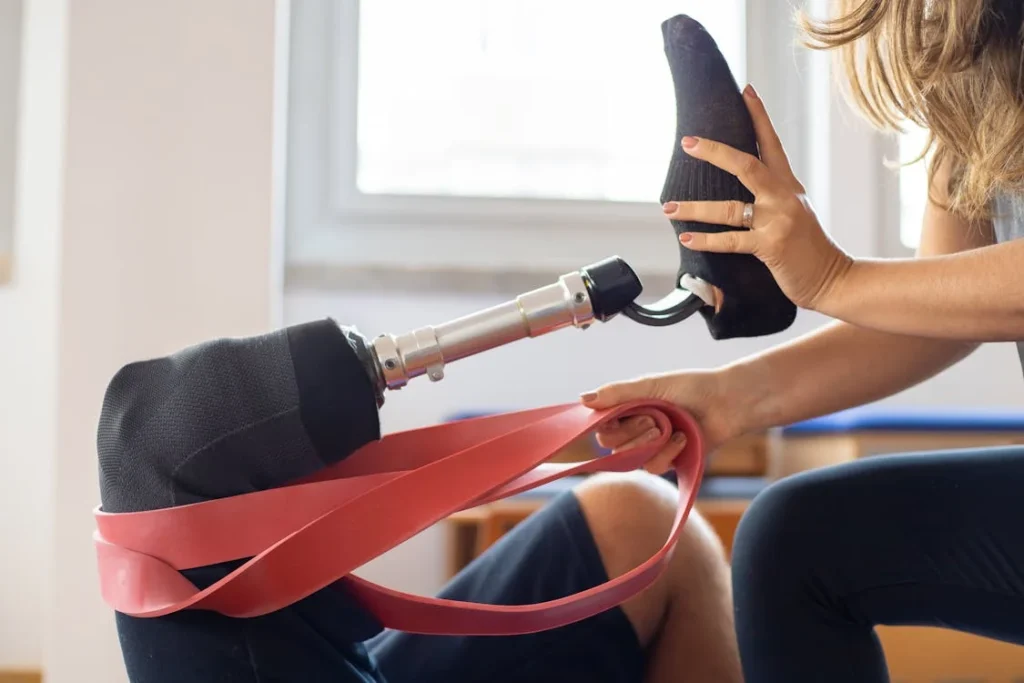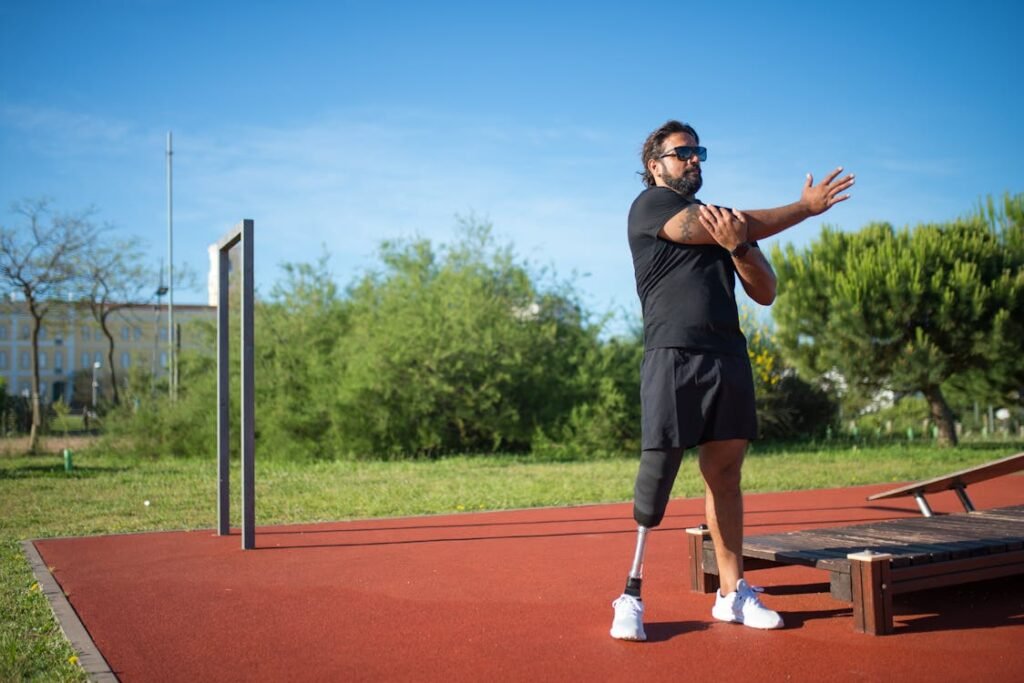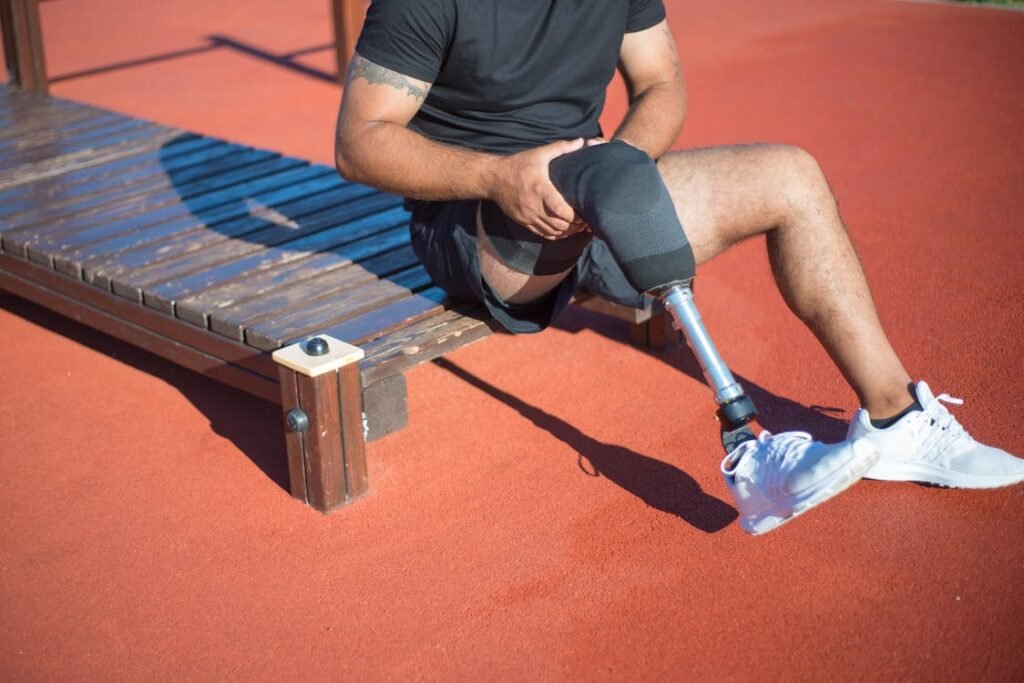Losing a limb is a life-changing event, both physically and emotionally. The road to recovery is not just about healing wounds and getting a prosthetic. Your body and mind need the right care to regain strength, mobility, and confidence. Three key factors play a huge role in this journey—sleep, diet, and physical therapy.
Each of these works together to help your body heal faster, build energy, and improve movement. Good sleep restores muscles and helps manage pain. The right diet gives your body the fuel it needs to heal and stay strong. Physical therapy keeps your muscles active and helps you adjust to using a prosthetic.
When all three are balanced, recovery becomes smoother, and daily life becomes easier. But if one is ignored, progress can slow down.

The Power of Sleep in Recovery
Sleep is one of the most important parts of healing after an amputation. It is the time when your body repairs itself, muscles recover, and the brain processes emotions.
After surgery, your body needs extra energy to heal, and sleep provides that. When you rest well, your immune system strengthens, inflammation reduces, and your mind feels more stable.
However, many people struggle with sleep after an amputation due to pain, discomfort, or emotional stress.
How Sleep Helps Your Body Heal
During deep sleep, your body releases growth hormones that help repair damaged tissues. This is especially important after surgery because your muscles, skin, and nerves all need time to regenerate.
Without enough sleep, healing slows down, and pain can feel more intense. Poor sleep also weakens the immune system, making it harder for the body to fight infections.
Pain management is another area where sleep plays a major role. When you don’t get enough rest, your body becomes more sensitive to pain.
Many amputees experience phantom limb pain, where the missing limb still feels sensations, often uncomfortable or painful. Good sleep can reduce the severity of this pain over time.
Mental health is also closely linked to sleep. Losing a limb brings emotional challenges, including anxiety and depression.
Sleep helps regulate mood, improve focus, and reduce feelings of stress. Without proper rest, emotions can feel overwhelming, making the recovery journey much harder.
Overcoming Sleep Struggles
It’s common to experience difficulty sleeping after an amputation. Pain, discomfort, and stress can make it hard to relax.
Finding a comfortable sleeping position is important. If you wear a prosthetic during the day, removing it before bed and elevating your residual limb can help reduce swelling and pressure.
A good mattress and pillows designed for support can also make a big difference.
Relaxation techniques, such as deep breathing and meditation, can help calm the mind before sleep. Creating a bedtime routine, like reading or listening to soothing music, can train your body to relax at night.
Avoiding caffeine and screen time before bed also helps improve sleep quality.
If pain is keeping you awake, talk to your doctor about pain management strategies. Sometimes adjusting medication, using warm compresses, or practicing light stretching before bed can reduce discomfort.
When sleep improves, everything else in recovery becomes easier. Your body feels stronger, your mind feels clearer, and your ability to move and adapt increases. Sleep is not just about rest—it is a key part of healing.

Nutrition: Fueling the Body for Recovery
What you eat after an amputation has a direct impact on your healing, energy levels, and overall recovery. Your body is working hard to repair tissues, reduce inflammation, and adjust to new physical demands.
The right diet provides the fuel needed for these processes. Eating well can speed up healing, strengthen muscles, and even help manage pain.
On the other hand, poor nutrition can slow down recovery and make daily activities harder.
How the Right Foods Help Your Body Heal
After an amputation, your body goes through significant changes. There is a higher demand for nutrients to support tissue repair and maintain muscle strength.
Protein plays a major role in this process because it helps rebuild muscles and tissues that may have weakened due to surgery or inactivity.
Lean meats, eggs, dairy, beans, and nuts are great sources of protein that can support healing.
Inflammation is a common issue after surgery, and the right foods can help control it. Antioxidant-rich foods like fruits, vegetables, and whole grains reduce inflammation and speed up recovery.
Omega-3 fatty acids, found in fish, flaxseeds, and walnuts, also have anti-inflammatory properties that help reduce pain and swelling.
Hydration is just as important as food. Water keeps your blood flowing properly, delivers nutrients to your cells, and flushes out toxins.
Dehydration can lead to fatigue, slow healing, and even increase muscle cramps. Drinking enough water throughout the day is essential for a smooth recovery.
Managing Weight and Energy Levels
Your body’s energy needs change after an amputation. Some people may need fewer calories if their activity level decreases, while others may need more energy if they are actively going through rehabilitation. Finding the right balance is key.
Gaining too much weight can put extra strain on your residual limb and make using a prosthetic more difficult.
On the other hand, losing too much weight too quickly can lead to muscle loss, making movement and balance harder.
Eating nutrient-dense foods—rather than processed foods high in sugar and unhealthy fats—helps maintain a healthy weight and keeps energy levels stable.
Blood sugar levels also play a role in energy and healing. Spikes and crashes in blood sugar can lead to fatigue and mood swings.
Eating balanced meals with a mix of protein, healthy fats, and complex carbohydrates helps keep energy levels steady throughout the day.
The Connection Between Diet and Mental Health
Food affects more than just the body—it also impacts the mind. The emotional side of recovery can be challenging, and the right nutrition can support mental well-being.
Certain foods help regulate mood by increasing the production of neurotransmitters like serotonin and dopamine, which affect feelings of happiness and relaxation.
For example, foods rich in B vitamins—like leafy greens, whole grains, and lean meats—help with brain function and reduce stress.
Magnesium-rich foods, such as nuts, seeds, and dark chocolate, promote relaxation and can even improve sleep quality.
Caffeine and sugar, on the other hand, can increase anxiety and disrupt sleep. Limiting these can lead to better mood stability and improved focus during physical therapy sessions.
A well-balanced diet works together with sleep and physical therapy to create the best conditions for healing.
When the body gets the right nutrients, it has the strength to recover, move efficiently, and adapt to life after amputation.

Physical Therapy: Regaining Strength and Mobility
After an amputation, your body has to relearn how to move. Muscles that were once used differently now take on new roles, and balance becomes a key focus.
Physical therapy is essential in this process. It strengthens the body, improves mobility, and helps prepare for using a prosthetic limb.
More than just exercise, physical therapy builds confidence, reduces pain, and makes daily life easier.
The Role of Physical Therapy in Recovery
Physical therapy starts soon after surgery. In the beginning, the focus is on reducing swelling, preventing stiffness, and keeping the remaining muscles strong.
Gentle movements help improve circulation, which is essential for healing. As the body recovers, therapy shifts towards building strength, improving flexibility, and restoring balance.
One major goal of therapy is to prevent muscle loss. After an amputation, muscles in the residual limb can weaken if they are not used.
Therapy helps keep these muscles active, ensuring they remain strong enough to support a prosthetic. Strengthening the core, back, and remaining limb is also important for overall stability and mobility.
Balance and coordination are other key areas of focus. Without a limb, the body’s center of gravity shifts, making movements feel unfamiliar at first.
Physical therapy helps retrain the body to move smoothly, reducing the risk of falls. If a prosthetic is being used, therapy helps the body adjust to it, making walking and daily activities feel more natural over time.
Pain management is another benefit of physical therapy. Phantom limb pain is common after an amputation, and regular movement can help reduce its intensity.
Stretching and specific exercises can also relieve pressure on joints and muscles, preventing discomfort that can arise from changes in posture and movement.
Preparing for Prosthetic Use
For those planning to use a prosthetic limb, physical therapy is crucial. Before wearing a prosthetic, the residual limb needs to be strong, flexible, and properly shaped.
Therapists guide patients through exercises that prepare the muscles and tissues for this transition.
Once a prosthetic is fitted, therapy shifts to learning how to use it effectively. Walking with a prosthetic requires practice and technique.
Physical therapists teach proper gait patterns, helping users develop smooth and natural movements. They also focus on posture, ensuring that the body stays aligned and balanced while using the prosthetic.
Therapists also help with functional training, which includes everyday tasks like standing, sitting, climbing stairs, and carrying objects. These exercises make it easier to return to normal activities with confidence.
Staying Consistent for Long-Term Success
Physical therapy doesn’t end when initial recovery is over. Continued movement is essential for maintaining strength and flexibility. Regular exercises keep the body in good shape, preventing stiffness and discomfort.
Even after becoming comfortable with a prosthetic, ongoing therapy can help improve mobility and reduce strain on the rest of the body.
Staying active also helps with overall health. Exercise improves circulation, boosts mood, and keeps energy levels high.
Whether through guided therapy sessions or at-home exercises, movement remains a key part of recovery long after the initial rehabilitation phase.
When physical therapy is combined with good sleep and proper nutrition, recovery becomes smoother and more effective. Each aspect supports the other, creating a strong foundation for adapting to life after amputation.

How Sleep, Diet, and Physical Therapy Work Together
Recovery after an amputation is not just about focusing on one area. Sleep, diet, and physical therapy all work together, each supporting the other to help the body heal and adapt.
When one is lacking, it can slow progress and make recovery more challenging. But when all three are in balance, the body gains the strength, energy, and resilience needed for a smoother transition to life after limb loss.
The Connection Between Sleep and Physical Therapy
Good sleep improves physical performance. When the body is well-rested, muscles recover faster, pain levels decrease, and energy levels increase.
This makes physical therapy sessions more effective. On the other hand, poor sleep can lead to fatigue, making it harder to stay motivated and push through exercises. It can also slow down muscle repair, delaying progress.
Physical therapy, in turn, helps improve sleep. Regular movement and stretching reduce pain and stiffness, making it easier to find a comfortable sleeping position.
Exercise also helps regulate sleep cycles by promoting relaxation and reducing stress. This creates a positive cycle where good sleep enhances therapy, and therapy improves sleep quality.
How Diet Supports Sleep and Therapy
The food you eat has a direct impact on both sleep and physical performance. A balanced diet provides the energy needed for physical therapy, while also ensuring the body has the nutrients required for muscle repair.
Protein helps rebuild tissues, healthy fats support joint health, and vitamins and minerals aid in reducing inflammation and strengthening the immune system.
Certain foods can also improve sleep quality. Magnesium-rich foods like almonds, spinach, and bananas promote relaxation, while foods high in tryptophan, such as turkey and dairy products, help produce melatonin, the hormone responsible for sleep.
On the other hand, too much caffeine or sugar can disrupt sleep, making recovery more difficult.
When diet, sleep, and therapy are aligned, they create a strong foundation for healing.
Eating well gives the body the strength to move, physical therapy keeps the body active and engaged, and quality sleep ensures that muscles and tissues recover properly.
The Mind-Body Connection in Recovery
Beyond the physical aspects, sleep, diet, and therapy also influence mental health. Recovery after amputation is not just about adjusting physically—it’s also an emotional journey.
Good nutrition helps regulate mood, reducing feelings of stress and anxiety. Physical activity releases endorphins, which improve mental well-being.
And sleep restores the brain, allowing it to process emotions and reduce feelings of overwhelm.
When one of these areas is neglected, it can create setbacks. Poor sleep can lead to low energy and lack of motivation for therapy.
A poor diet can make the body feel sluggish and slow healing. Skipping physical therapy can lead to stiffness and increased pain, making it harder to rest.
But when all three are prioritized, they create a cycle of progress, making recovery smoother and daily life easier.
By paying attention to sleep, diet, and physical therapy, individuals can regain their strength, improve mobility, and feel more in control of their recovery.
Every small step in these areas adds up, leading to long-term success and a better quality of life.

Emotional and Psychological Impact of Recovery
Healing after an amputation isn’t just about the body—it’s also about the mind. The emotional and psychological impact of limb loss can be just as challenging as the physical recovery.
Feelings of grief, frustration, and anxiety are normal, and adapting to a new way of life takes time. Addressing mental health is just as important as focusing on sleep, diet, and physical therapy.
When the mind is supported, the body responds better, and recovery becomes smoother.
Coping with Change and Finding Acceptance
Amputation is a major life change, and it’s natural to feel a range of emotions during recovery. Some days may feel overwhelming, while others bring progress and hope.
Many people go through a grieving process, as they adjust to the loss of a limb and the changes it brings. This process takes time, and each person moves through it at their own pace.
Acceptance is a key part of emotional healing. While it doesn’t mean ignoring difficulties, it does mean finding ways to move forward.
Connecting with others who have experienced amputation can be helpful. Support groups, both in-person and online, provide a space to share experiences, ask questions, and gain encouragement from those who understand the journey firsthand.
Family and friends also play an important role. Open conversations about challenges and feelings can help reduce stress and create a strong support system.
It’s okay to ask for help when needed, whether it’s with daily tasks, emotional support, or simply having someone to talk to.
Managing Stress and Anxiety During Recovery
Recovery brings many new experiences—learning to use a prosthetic, going through physical therapy, adjusting to changes in mobility.
These changes can sometimes lead to stress and anxiety, making it harder to focus on healing. Finding ways to manage stress is essential for both mental and physical well-being.
Mindfulness techniques, such as meditation and deep breathing exercises, can help calm the mind and reduce anxiety.
Taking a few minutes each day to focus on breathing, relaxation, or even gentle movement can make a big difference in managing emotions.
Engaging in enjoyable activities also helps reduce stress. Hobbies, music, reading, or spending time outdoors can provide a break from the challenges of recovery and bring a sense of normalcy.
Even small moments of joy can have a big impact on overall well-being.
Physical movement also helps with emotional balance. While physical therapy focuses on strength and mobility, general movement—such as stretching, light yoga, or even walking—can release endorphins, which naturally boost mood and reduce stress.
Overcoming Fear and Building Confidence
A common challenge after an amputation is fear—fear of falling, fear of pain, or fear of not being able to return to normal activities. These fears are valid, but they can be overcome with time and practice.
Setting small, achievable goals can help build confidence. Whether it’s standing for a few extra minutes, walking a short distance, or trying a new movement in therapy, each step forward is a victory.
Celebrating progress, no matter how small, can help shift focus from what has changed to what is possible.
Working with a physical therapist, occupational therapist, or counselor can also help address fears and create strategies for overcoming them.
Having guidance and encouragement makes a difference in feeling more in control of recovery.
Mental and emotional health are deeply connected to physical healing. When the mind feels supported, the body responds better.
A balanced recovery includes not only rest, nutrition, and movement but also emotional well-being. By taking care of both the body and mind, life after amputation becomes easier, more fulfilling, and full of new possibilities.

The Role of Adaptability in Everyday Life After Amputation
Recovery after an amputation is not just about healing—it’s about learning how to adapt. Every aspect of daily life changes, from getting out of bed in the morning to performing basic tasks like cooking, dressing, and moving around.
While physical therapy, sleep, and nutrition lay the foundation for healing, adaptability is what helps a person regain independence and confidence.
Learning new ways to complete tasks, adjusting to a prosthetic, and developing problem-solving skills all play a major role in building a fulfilling life after limb loss.
Finding New Ways to Perform Daily Tasks
One of the biggest adjustments after an amputation is learning how to complete everyday tasks in a way that works for the body’s new abilities.
Simple things that were once done automatically—tying shoes, carrying groceries, or using household appliances—may now require new techniques.
This learning process can be frustrating at times, but with patience and practice, it becomes easier. Occupational therapy helps individuals develop strategies for daily living, whether that means using assistive devices, modifying the home environment, or building strength and flexibility to perform tasks more comfortably.
For someone with a lower limb amputation, balance and movement become key areas of focus. Navigating stairs, getting in and out of a car, or simply standing for long periods requires new techniques.
Physical therapy helps strengthen the muscles needed for stability, but real-world practice is where true adaptability develops. If using a prosthetic, the first few weeks may feel awkward, but as the body adjusts, movements become more natural.
For individuals with an upper limb amputation, grip strength and dexterity become important factors. Simple actions like buttoning a shirt, writing, or using utensils may require adjustments.
Prosthetic hands, like Robobionics’ Grippy™, offer advanced functionality, but it still takes time to master fine motor skills. Practicing small movements daily and experimenting with different techniques can help improve coordination and ease.
Adjusting to Social and Work Environments
Beyond physical tasks, social interactions and workplace adjustments also play a role in post-amputation adaptation. Confidence in public spaces, navigating social situations, and returning to work can feel overwhelming at first.
Many people worry about how others will react to their prosthetic or how they will handle questions from colleagues and friends. Over time, these concerns lessen as comfort and self-assurance grow.
In professional settings, some job roles may require modifications. Standing for long periods, lifting objects, or using specialized equipment might need adjustments, but many workplaces are open to accommodations that make tasks more manageable.
Talking to employers about specific needs and exploring assistive tools can help create a work environment that supports productivity without unnecessary strain.
Socially, it’s common to experience moments of self-consciousness, but embracing one’s new reality is an important step toward confidence.
Whether it’s choosing to wear a prosthetic openly, using humor to ease conversations, or surrounding oneself with supportive people, finding comfort in new circumstances is key.
Many individuals find that connecting with others who have experienced amputation provides valuable encouragement and motivation.
Strengthening the Mindset for Long-Term Success
Adaptability is not just about learning new physical skills; it’s also about developing the right mindset. A growth-oriented approach to recovery can make the difference between frustration and progress.
Every challenge presents an opportunity to grow stronger and more independent. The body may need time to adjust, but the willingness to try, fail, and try again is what leads to success.
Setting small, realistic goals each day creates a sense of achievement. Whether it’s walking a little farther, improving prosthetic control, or learning a new task, each victory builds confidence.
Patience is crucial—some days will feel easier than others, and setbacks are a natural part of the process. The key is to focus on long-term progress rather than short-term difficulties.
Support systems also play a big role in adaptation. Encouragement from family, friends, therapists, and support groups can make a tremendous difference. Having people to celebrate successes, share frustrations, and offer advice helps maintain motivation and positivity.
Life after amputation is not about going back to how things were—it’s about moving forward with new possibilities. With time, practice, and the right mindset, adapting to daily life becomes second nature.
Each challenge overcome is a step toward independence, proving that life after limb loss can be just as fulfilling, active, and full of opportunities as before.
Conclusion
Recovery after an amputation is a journey that involves more than just physical healing. Sleep, diet, and physical therapy work together to build strength, reduce pain, and restore mobility. When these areas are balanced, the body recovers faster, energy levels remain steady, and adapting to life with a prosthetic becomes easier. At the same time, emotional well-being and adaptability play a crucial role in regaining confidence and independence.
Healing is not about returning to life as it was before—it’s about moving forward with new abilities and possibilities. Every challenge faced is an opportunity for growth, and with patience, support, and persistence, daily tasks become second nature again. Robobionics is committed to supporting individuals throughout this journey with advanced prosthetic solutions like Grippy™ and a structured rehabilitation process that makes adaptation smoother.
No matter where you are in your recovery, small steps lead to big progress. Prioritize rest, nourish your body, stay active, and embrace the learning process. With time, you will regain control, confidence, and the ability to live life fully. If you’re ready to take the next step, explore how Robobionics can support your journey today.



